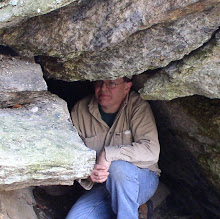Landing on the west shore of the Narragansett Bay, it was my intention to kick off fours days with further water-based explorations of the rocky coastlines in the Bay. On this day I went south looking over the coast of the Bonnet, and an area just to its south. At that point I paddled across the West Passage of the Narragansett Bay to re-examine a section of Conanicut Island (Jamestown) seen in June. What I thought to be a cave previously was merely the all too typical recess and shadow in the rocks.
The second day was devoted to exploring a number of sites on the northern portion of Aquidneck Island. A stand old growth forest managed to escaped the ravages of time. Then I fulfilled a long desire to look at some of the coal history of Portsmouth, examining several shoreline sites while also looking at a couple possible future kayak put-ins. Sandwiched in there was a quick walk by a section the old Hessians Hole, part of the early Portsmouth history. Finishing the day: a long awaited trip to another historic site: Lawton Valley, once the location of early grist mills.
I returned to water and coastal explorations on the third day. This time from Jamestown itself. Leaving the Fort Wetherill area, I re-examined some sections visited last year and was pleasantly surprised by the find of a shallow sea cave. One (Pirate's Cave) has been reported in this area for many years and this is the only likely possibility I have ever come across. Then it was only to shoot across the mouth of Mackerel Cove, leaving granite behind for a more slaty Rhode Island Formation. Cruising down the coast I saw another possible cave site and visited (unfortunately at high tide) a number or rocky formations including the Bay's major sea formed cave. On my returned, I looked over the two recently discovered cave sites while capturing photos. The day was closed out by a low tide visit to a site on Aquidneck visited the previous day, revealing much more rocks including fossil bearing formations.
Day four saw me leaving Aquidneck Island and making my way up to the Snake Den. A multitude of old granite quarries exist here as well as the rocky ridge know as Snake Den. Some small cave formations do exist here. I attempted to work a nearby site known as Round Rocks only to find roads into the area closed - or non existent. A later aerial view search reveals the area now incorporated into a massive quarrying operation.





